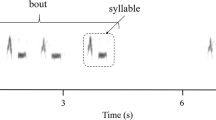Abstract
Analysis of the acoustic signal of the chuck vocalizations of adult female squirrel monkeys (Saimiri sciureus) in Parque Nacional de Manu, Peru, revealed consistent differences within and between individuals. We quantified four peak frequency parameters: (a) the peak frequency of single chucks, (b) the first and (c) the second peak frequencies of double chucks, and (d) the peak difference: the difference between the first and the second double chuck peaks. One-way ANOVAs and a posteriori comparisons of these variables revealed that each distinguished more than 70% of all possible pairs of females. When all double chuck measures were included in a discriminant analysis, 57% of double chucks were correctly assigned to the caller. Another category of information potentially encoded in the acoustic structure of chuck vocalizations is foraging activity. When the chucks of squirrel monkeys during foraging and nonforaging activities were compared, the single chuck peak frequency, and the first peak frequency and the peak difference of double chucks, were significantly reduced during foraging contexts. Previously Boinski and Mitchell (1992) concluded that chucks facilitate group cohesion among widely dispersed troop members by providing information of the location of callers; the rate of chucks produced by an adult female increases as she becomes more spatially and visually separated from other adult females. The additional information potentially conveyed by chucks on caller identity and foraging activity documented in these new analyses further emphasizes the role chucks serve to enhance group coordination and cohesion.
Similar content being viewed by others
REFERENCES
Aich, H., Moos-Heilen, R., and Zimmerman, E. (1990). Vocalizations of adult gelada baboons (Theropithecus gelada): Acoustics and behavioral context. Folia Primatol. 55: 109–132.
Barclay, D., and Maurus, M. (1992). Interdependency between structural components in squirrel monkey calls: Function and sequential context. In Nishida, T., McGrew, W. C., Marler, P., Pickford, M., and de Waal, F. B. M. (eds.), Topics in Primatology, Vol. 1, University of Tokyo Press, Tokyo, pp. 211–224.
Beecher, M. D. (1974). Pure tone thresholds of the squirrel monkey (Saimiri sciureus). J. Acoust. Soc. Am. 55: 196–188.
Beecher, M. D. (1982). Signature systems and kin recognition. Am. Zool. 22: 477–490.
Beecher, M. D., Loesche, P., Stoddard, P. K., and Melvin, M. B. (1989). Individual recognition by voice in swallows: Signal or perceptual adaptation? In Dooling, R. J., and Hulse, S. H. (eds.), The Comparative Psychology of Audition: Perceiving Complex Sounds, Lawrence Erlbaum, Hillsdale, NJ, pp. 277–292.
Benz, J. J. (1993). Food-elicited vocalizations in golden lion tamarins: Design features for representational communication. Anim. Behav. 45: 443–455.
Biben, M. (1993). Recognition of order effects in squirrel monkey antiphonal call sequences. Am. J. Primatol. 29: 109–124.
Biben, M., and Symmes, D. (1991). Playback studies of affiliative vocalizations in captive squirrel monkeys: Familiarity as a cue to response. Behaviour 117: 1–19.
Biben, M., Symmes, D., and Masataka, N. (1986). Temporal and structural analysis of vocal exchanges in squirrel monkeys (Saimiri sciureus). .Behaviour 98: 259–273.
Boinski, S. (1991). The coordination of spatial position: A field study of the vocal behavior of adult female squirrel monkeys. Anim. Behav. 41: 89–102.
Boinski, S., and Campbell, A. F. (1996). The huh vocalization of white-faced capuchins: a spacing call disguised as a food call? Ethology 102: 826–840.
Boinski, S., and Mitchell, C. L. (1992). The ecological and social factors affecting adult female squirrel monkey vocal behavior. Ethology 92: 316–330.
Boinski, S., and Mitchell, C. L. (1995). Wild squirrel monkey (Saimiri sciureus) “caregiver calls: contexts and acoustic structure. Am. J. Primatol. 35: 129–138.
Boinski, S., Moraes, E., Kleiman, D., Deitz, J., and Baker, A. (1994). Intra-group vocal behavior in wild golden lion tamarins, Leontopithecus rosalia: Honest communication of individual activity. Behaviour 130: 53–76.
Boinski, S., and Newman, J. D. (1988). Preliminary observations on squirrel monkey (Saimiri oerstedi) vocalizations in Costa Rica. Am. J. Primatol. 14: 329–343.
Brown, C. H., Gomez, R., and Waser, P. M. (1995). Old World monkey vocalizations: Adaptation to the local habitat? Anim. Behav. 50: 945–961.
Butynski, T. M., Chapman, C. A, Chapman, L. J., and Weary, D. M. (1992). Use of male blue monkey “pyow” calls for long-term individual identification. Am. J. Primatol. 28: 183–189.
Caine, N. G. Addington, R. L., and Windfelder, T. L. (1995). Factors affecting the rates of food calls given by red-bellied tamarins. Anim Behav. 50: 53–60.
Chapman, C. A., and Veary, D. M. (1990). Variability in spider monkeys' vocalizations may provide basis for individual recognition. Am. J. Primatol. 22: 279–284.
Cleveland, J., and Snowdon, C. T. (1982). The complex vocal repertoire of the adult cotton-top tamarin (Saguinus oedipus oedipus). Z. Tierpsychol. 58: 231–270.
East, M. L., and Hofer, H. (1991). Loud calling in a female-dominated mammalian society. I. Structure and composition of whooping bouts of spotted hyenas, Crocuta crocuta. Anim. Behav. 42: 637–650.
Elgar, M. A. (1986). The establishment of foraging flocks in house sparrows: Risk of predation and daily temperature. Behav. Ecol. Sociobiol. 19: 433–438.
Evens, R. M. (1982). Foraging-flock recruitment at a black-billed gull colony: Implications for the information center hypothesis. Auk 99: 24–30.
Fay, R. R. (1988). Hearing in Vertebrates: A Psychophysics Databook, Hill-Fay, Winnetka, IL.
Fitch, T. S., and Hauser, M. D. (1995). Vocal production in nonhuman primates: Acoustics, physiology, and functional constraints on “honest” advertisement. Am. J. Primatol. 37: 191–219.
Glass, I., and Wollberg, Z. (1983). Auditory cortex responses to sequences of normal and reversed squirrel monkey vocalizations. Brain Behav. Evol. 22: 13–21.
Gouzoules, H., Gouzoules, S., and Ashley, J. (1995). Representational signaling in nonhuman primate vocal communication. In Zimmerman, E., Newman, J. D., and Jürgens, U. (eds.), Current Topics in Primate Vocal Communication, Plenum Press, New York, pp. 235–252.
Green, S. (1975a). Auditory sensitivity and equal loudness in the squirrel monkey (Saimiri sciureus) .J. Exp. Anal. Behav. 23: 55–264.
Green, S. (1975b). Dialects in Japanese monkeys: vocal learning and cultural transmission of locale-specific behavior. Z. Tierpsychol. 38: 304–314.
Hepper, P. G. (1991). Kin Recognition, Cambridge University Press, Cambridge.
Herzog, M., and Hopf, S. (1983). Effects of species-specific vocalizations on the behaviour of surrogate-reared squirrel monkeys. Behaviour 86: 197–214.
Janson, C. H., and Boinski, S. (1992). Morphological and behavioral adaptations for foraging in generalized primates: The case of the cebines. Am. Phys. Anthropol. 8: 483–498.
Jürgens, U. (1982). A neuroethological approach to the classification of vocalization in the squirrel monkey. In Snowdon, C. T., Brown, C. H., and Peterson, M. R, (eds), Primate Communication, Cambridge University Press, Cambridge, pp. 50–62.
Jürgens, U. (1988). Central control of monkey calls. In Todt, D., Goedeking, P., and Symmes, D. (eds.), Primate Vocal Communication, Springer-Verlag Berlin, pp. 162–167.
Lieberman, P., Klatt, D. H., and Wilson, W. H. (1969). Vocal tract limitations on the vowel repertoires of rhesus monkeys and other nonhuman primates. Science 164: 1185–1187.
Lind, H., Dabelsteen, T., and McGregor, P. K. (1996). Female great tits can identify mates by song. Anim. Behav. 52: 667–671.
Macedonia, J. M. (1986). Individuality in a contact call of the ringtailed lemur (Lemur catta). Am. J. Primatol. 11: 163–179.
Marler, P., Duffy, A., and Pickert, R. (1986). Vocal communication in the domestic chicken. 1. Does a sender communicate information about the quality of a food referent to a receiver? Anim. Behav. 34: 188–193.
Marler, P., Evans, C. S., and Hauser, M, D. (1992). Animal signals: Motivational, referential, or both? In Papousek, H., Jürgens, U., and Papousek, M. (eds.), Nonverbal Communication: Comparative and Development Approaches, Cambridge University Press, Cambridge, pp. 66–86.
Mitani, J. C., Gros-Louis, J., and Macedonia, J. M. (1996). Selection for acoustic individuality within the vocal repertoire of wild chimpanzees. Int. J. Primatol. 17: 569–583.
Mitchell, C. L. (1990). The Ecological Basis for Female Social Dominance: A Behavioral Study of the Squirrel Monkey, Ph.D. thesis, Princeton University, Princeton, NJ.
Mitchell, C. L. (1994). Migration alliances and coalitions among adult South American squirrel monkeys (Saimiri sciureus) . Behaviour 130: 169–188.
Mitchell, C. L., Boinski, S., and van Schaik, C. P. (1991). Competitive regimes and female bonding in two species of squirrel monkey (Saimiri oerstedi and S. sciureus) Behav. Ecol. Sociobiol. 28: 55–60.
Moynihan, M. H. (1962). The organization and probable evolution of some mixed-species flocks of birds. Smith. Misc. Coll. 143: 1–140.
Newman, J. D., Smith, H. J., and Talmadge-Riggs, G. (1983). Structural variability in primate vocalizations and its functional significance: An analysis of squirrel monkey chuck calls. Folia Primatol. 40: 114–124.
Ploog, D., Hupfer, K., Jürgens, U., and Newman, J. D. (1975). Neuroethologic studies of vocalization in squirrel monkeys with special reference to genetic differences of calling in two subspecies. In Brazier, M. A. B. (ed.), Growth and Development of the Brain, Raven Press, New York, pp. 231–254.
Rendall, D., Rodman, R. S., and Emond, R. E. (1996). Vocal recognition of individuals and kin in free-ranging rhesus monkeys. Anim. Behav. 51: 1007–1015.
Robinson, J. G. (1982). Vocal systems regulating within-group spacing. In Snowdon, C. T., Brown, C. H., and Peterson, M. (eds.), Primate Communication, Cambridge University Press, Cambridge, pp. 94–116.
Smith, H. J., Newman, J. D., Hoffman, H. J., and Fetterly, K. (1982a). Statistical discrimination among vocalizations of individual squirrel monkeys (Saimiri sciureus) .Folia Primatol. 37: 267–279.
Smith, H. J., Newman, J. D., and Symmes, D. (1982b). Vocal concomitants of affiliative behavior in squirrel monkeys (Saimiri sciureus). In Snowdon, C. T., Brown, C. H., and Peterson, M. (eds.), Primate Communication, Cambridge University Press, Cambridge, pp. 94–116.
Terborgh, J. (1983). Five New World Primates: A Study in Comparative Ecology, Princeton University Press, Princeton, NJ.
Thorington, R. W., Jr. (1968). Observations of squirrel monkeys in a Colombian forest. In Rosenblum, L. A., and Cooper, R. W. (eds.), The Squirrel Monkey, Academic Press, New York, pp. 69–85.
Winter, P. (1972). Observations on the vocal behavior of free-ranging squirrel monkeys. Z. Tierpsych. 31: 1–7.
Winter, P., Ploog, P., and Latta, J. (1966). Vocal repertoire of the squirrel monkey (Saimiri stiureus), its analysis and significance. Exp. Brain Res. 1:359–384.
Zimmerman, E., and Lerch, C. (1993). The complex acoustic design of an advertisement call in male mouse lemurs (Microcebus murinus, Prosimii, Primates) and sources of its variation. Ethology 93: 211–224.
Author information
Authors and Affiliations
Corresponding author
Rights and permissions
About this article
Cite this article
Boinski, S., Mitchell, C.L. Chuck Vocalizations of Wild Female Squirrel Monkeys (Saimiri sciureus) Contain Information on Caller Identity and Foraging Activity. International Journal of Primatology 18, 975–993 (1997). https://doi.org/10.1023/A:1026300314739
Issue Date:
DOI: https://doi.org/10.1023/A:1026300314739




